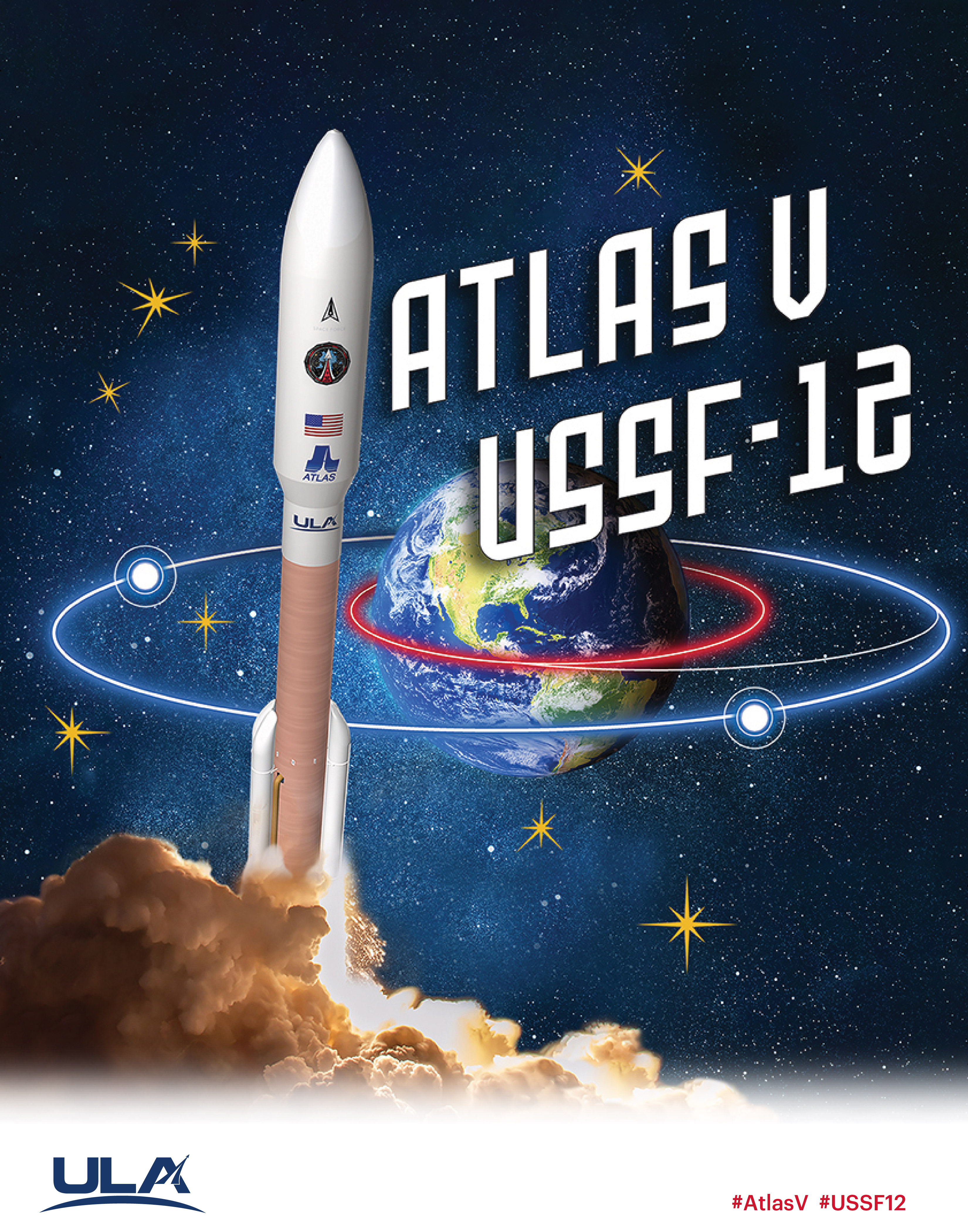Atlas V Successfully Launches USSF-12
A United Launch Alliance (ULA) Atlas V 541 rocket launched the USSF-12 mission for the U.S. Space Force’s Space Systems Command (SSC). Liftoff occurred from Space Launch Complex-41 at Cape Canaveral Space Force Station, Florida.
Launch Date and Time: Friday, July 1, 2022 at 7:15 p.m. EDT (2315 UTC)
Go Atlas! Go Centaur! Go USSF-12!
Launch Webcast
Webcast begins Friday at 5:40 p.m. EDT (2140 UTC)
Live updates
To keep up to speed with updates to the launch countdown, dial the ULA launch hotline at 1-877-852-4321.
Join the conversation at Twitter, Facebook, Instagram and
LinkedIn
#AtlasV #USSF12
Mission Overview
A United Launch Alliance (ULA) Atlas V 541 rocket is launching the USSF-12 mission for the U.S. Space Force’s Space Systems Command (SSC). USSF-12 features two satellite payloads: the Wide Field of View (WFOV) Testbed for SSC's Space Sensing Directorate and the USSF-12 Ring spacecraft for the Defense Department’s Space Test Program. Atlas V will deliver both spacecraft directly to geosynchronous orbit approximately 22,000 miles (35,500 km) above the equator approximately 6 hours after liftoff. Liftoff will occur from Space Launch Complex-41 at Cape Canaveral Space Force Station, Fla.
The forward payload, WFOV, is a testbed spacecraft that informs the Next Gen Overhead Persistent Infrared program (OPIR). The Next Gen OPIR program will succeed the Space Based Infrared Systems program and is designed provide a resilient space-based global missile warning capability against emerging missile and counter-space threats. Sponsored by Space Systems Command and managed by the NASA Ames Research Center, the mid-sized WFOV spacecraft is based on Millennium’s AQUILA M8 affordable platform series and hosts a transformational OPIR six-degree staring sensor developed under a separate contract by L3Harris Technologies. The WFOV testbed is designed for a 3- to 5-year life with a total mass up to 6,613 lbs (3,000 kg) and a payload accommodation over 771 lbs (350 kg). WFOV’s primary mission in orbit is to explore future missile warning algorithms with data collected in space.
The aft payload is a propulsive ESPA named the USSF-12 Ring. The Ring is a classified mission to demonstrate future technology for the Department of Defense.
Launch Vehicle
Payload Fairing (PLF)
The spacecraft are encapsulated in a 17-ft (5-m) diameter short payload fairing produced in the advanced Out-of-Autoclave manufacturing process. The 5-m PLF is a sandwich composite structure made with a vented aluminum-honeycomb core and graphite-epoxy face sheets. The bisector (two-piece shell) PLF encapsulates both the Centaur and the satellite. The vehicle’s height with the 5-meter short PLF is approximately 196 ft (59.7 m).
Centaur
The Centaur second stage is 10 ft (3 m) in diameter and 41.5 ft (12.6 m) in length. Its propellant tanks are pressure-stabilized and constructed of corrosion-resistant stainless steel. Centaur is a cryogenic vehicle, fueled with liquid hydrogen and liquid oxygen, powered by an RL10C-1 engine producing 22,900 lbs (101.8 kilo-Newtons) of thrust. The cryogenic tanks are insulated with a combination of helium-purged blankets, radiation shields and spray-on foam insulation (SOFI). The Centaur forward adapter (CFA) provides structural mountings for the fault-tolerant avionics system and structural and electrical interfaces with the spacecraft.
Booster
The booster is 12.5 ft (3.8 m) in diameter and 106.5 ft (32.5 m) in length. The booster’s tanks are structurally rigid and constructed of isogrid aluminum barrels, spun-formed aluminum domes and intertank skirts. Booster propulsion is provided by the RD-180 engine system (a single engine with two thrust chambers). The RD-180 burns RP-1 (Rocket Propellant-1 or highly purified kerosene) and liquid oxygen and delivers 860,200 lbs (3.83 mega-Newtons) of thrust at sea level. Four solid rocket boosters (SRBs) generate the additional power required at liftoff, with each providing 371,550 lbs (1.6 mega-Newtons) of thrust. The Centaur avionics system, provides guidance, flight control and vehicle sequencing functions during the booster and Centaur phases of flight.
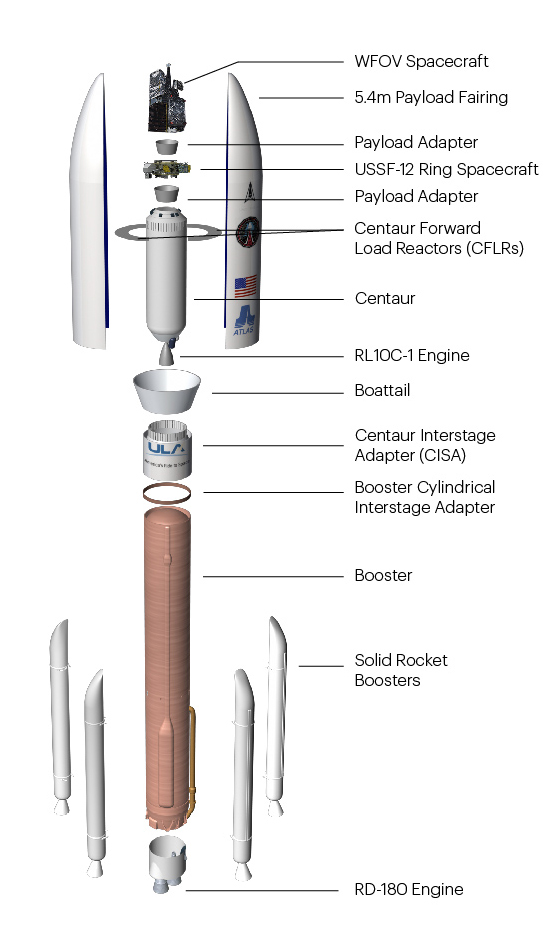
Flight Profile
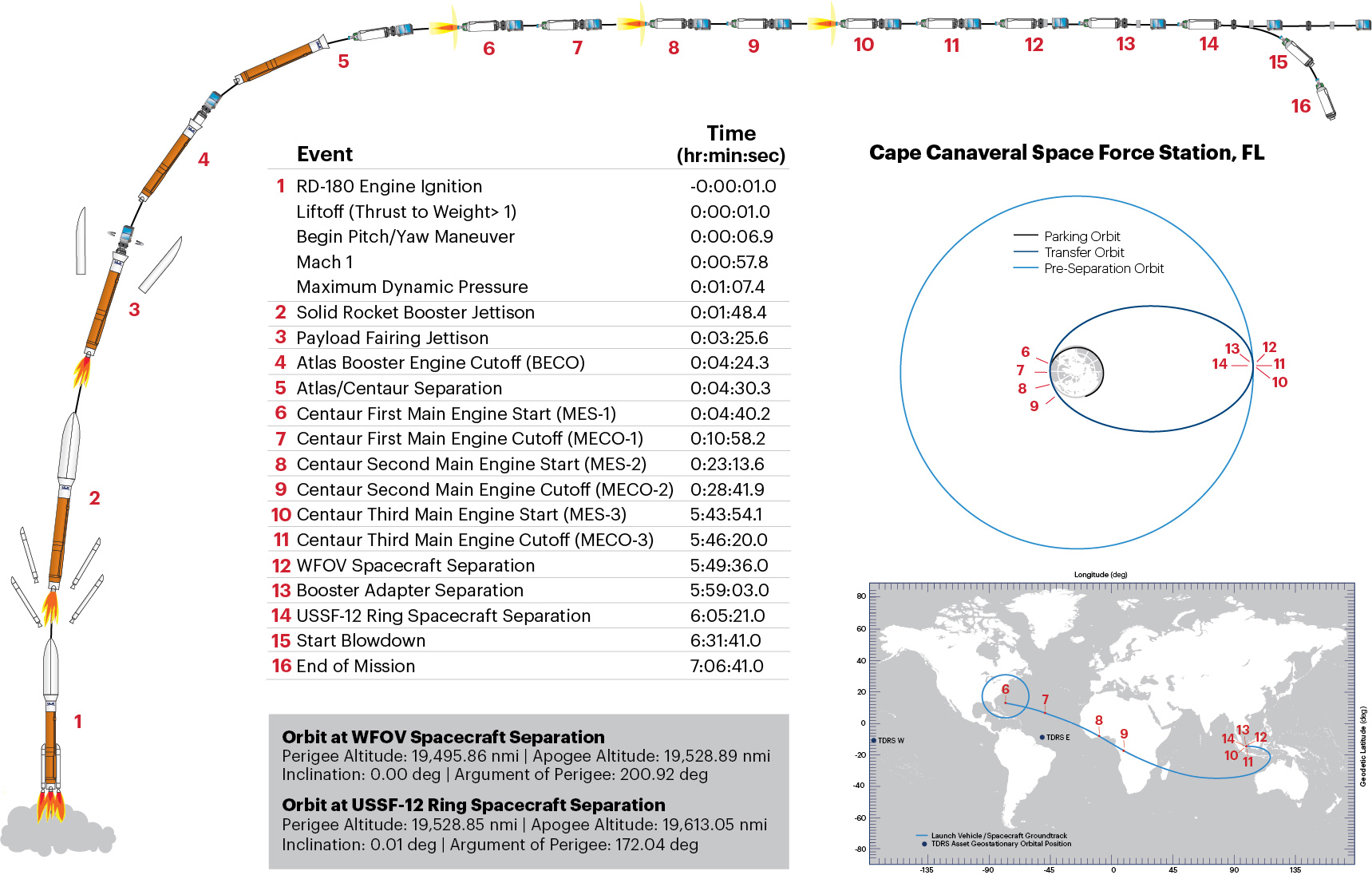
Space Launch Complex-41 // Processing
Space Launch Complex-41, the East Coast home of the Atlas V rocket at Cape Canaveral Space Force Station in Florida, employs a “clean pad” concept of operations to ready launch vehicles and payloads for ascent into space. The rocket elements are assembled atop a Mobile Launch Platform inside the Vertical Integration Facility (VIF) located adjacent to the launch pad. The platform and fully stacked Atlas V then travel by rail approximately 1,800 feet northward from the VIF to the pad for the final countdown, fueling and liftoff. Complex 41 was constructed by the U.S. Air Force in the 1960s for the Titan rocket program. The site was rejuvenated in support of the Atlas V starting in the late 1990s.
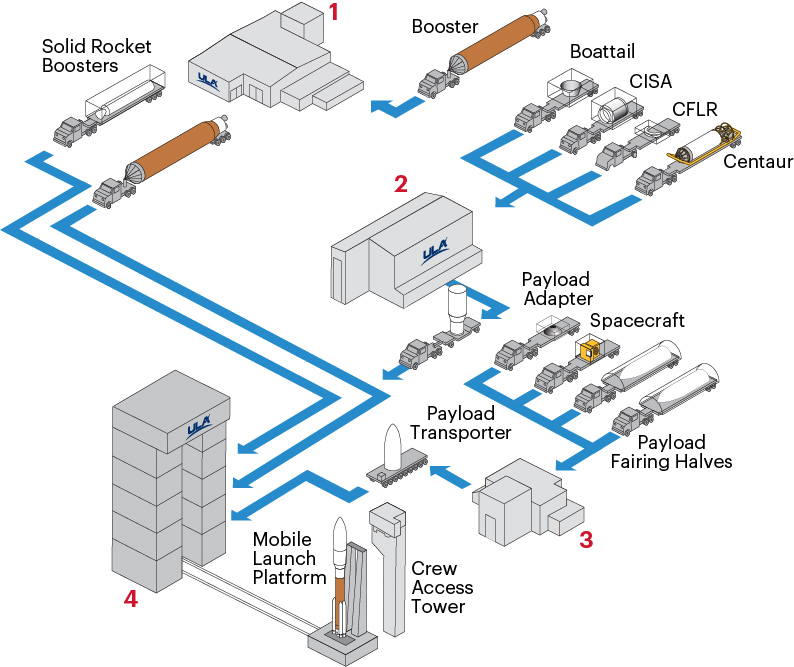
1. Atlas Spaceflight Operations Center (ASOC)
Launch Control Center
Mission Director’s Center,
Mission Support
Teams,
Launch Vehicle Horizontal Processing &
Ordnance Installation
2. Delta Operations Center
Offline Vertical Integration (OVI):
Interstage Adapters, Centaur,
Boattail, Base Module & Centaur
Forward Load Reactor Deck
3. Spaceflight Processing Facility
Spacecraft Processing,
Testing & Encapsulation
4. Vertical Integration Facility
Launch
Vehicle Integration &
Testing, Spacecraft Mate &
Integrated Operations
Production
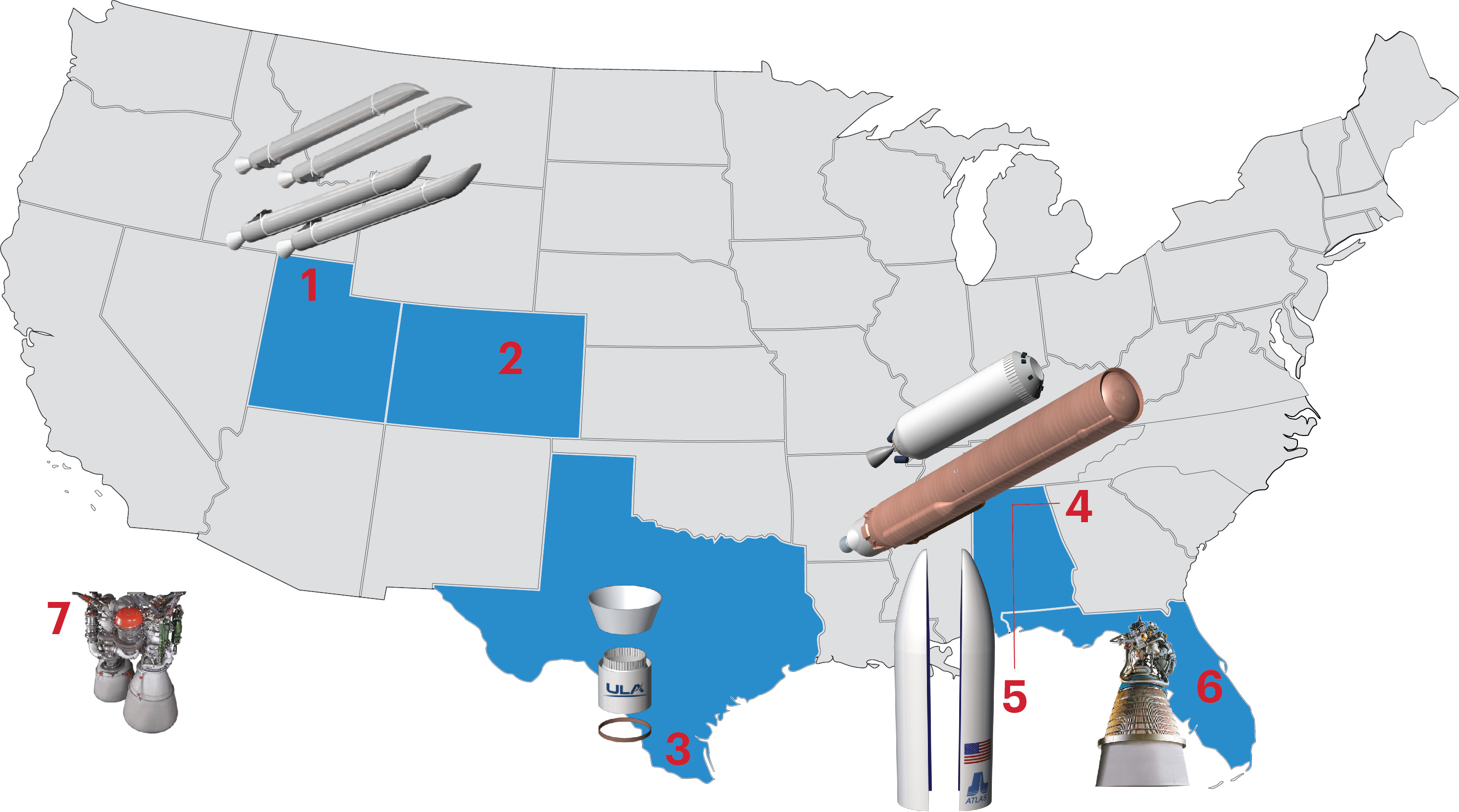
1. Promontory, UT
Solid Rocket Booster Fabrication
at Northrop Grumman
2. Denver, CO
ULA Headquarters &
Design Center Engineering
3. Harlingen, TX
Payload Adapter,
Booster Adapter &
Centaur Adapter Fabrication
4. Decatur, AL
Booster Fabrication & Final Assembly,
Centaur Tank Fabrication & Final Assembly
5. Decatur, AL
5-m Payload Fairing
Fabrication at Beyond Gravity
6. West Palm Beach, FL
RL10C-1 Engine Fabrication at
Aerojet Rocketdyne
7. Khimki, Russia
RD-180 Engine Fabrication at
NPO Energomash


